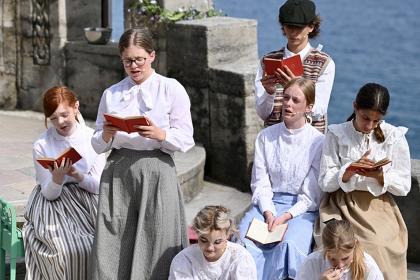by Silva Semerciyan
presented by students of the Minack Acting Academy
Sometimes we see what we want to...
1917. In the fourth year of the Great War, 17 year-old Elsie Wright borrows her father’s camera and fakes photographs of herself and her young cousin Frances talking with fairies at the bottom of their garden. But she is quite unprepared for the excitement her pictures will unleash. Soon the girls find themselves at the centre of a celebrity media storm. Their photos are published around the world and Sir Arthur Conan-Doyle, creator of Sherlock Holmes, champions them as scientific evidence of psychic phenomena. But can these fragile images and their young creators withstand the cruel light of press scrutiny?
Based on the true story of the Cottingley Fairies, The Light Burns Blue is a tale of deception, public hysteria and the ethical boundaries of new technologies. Are Elsie’s photographs just a thoughtless hoax or the cynical exploitation of people’s need to believe in a world beyond the horrors of war? Or should we view them an artistic exploration of the possibilities of early photography? One thing is certain, the echoes of Elsie and Frances’s story can be felt today in our arguments and questions over AI.
This amateur production is presented by arrangement with Nick Hern Books.
Review by Jane Pugh
The Light Turns Blue
In 1917, teenager, Elsie Wright, borrowed her photographer father’s camera and, with the help of her exuberant young cousin, Frances, took pictures of a cluster of fairies they’d discovered amongst the trees of Cottingley, a cloistered village in Yorkshire. Endorsed by the mighty Arthur Conan Doyle, a believer in the spiritual world, the girls and their photographs gripped the public imagination, a public desperate to transcend an earthbound world war and flu epidemic.
Only they were fake. Elsie a gifted artist, constructed cut-out fairies and positioned them in the rich soil, amongst the dark foliage with hat pins. To say the photos were visually arresting is an understatement.
This is a touching story of deception verses truth and the students of the Minack Acting Academy tackle it with robust muscularity, there’s not a moment of whimsy or sentimentality as they directly and purposefully argue differences between truth and belief. If you can believe in God then surely you can believe in fairies too. Paintings of Christ on the Cross are a construct and so too are photographs of faked fairies. In the most chilling and heartbreaking scene, Elsie assists her father take a studio photograph of a dead soldier, propped up and in uniform, as a macabre keepsake for his shattered parents. He’s dead but that truth is too hard and wretched to accept. So, let’s pretend. Then, civilians lived amongst death and the threat of death, the dread of the telegram, and the blurring of the two is amply and confidently explored.
And whilst it’s a serious play, the Minack Academy bring a heart thumping, blood pumping energy and joie de vivre. The men’s England football team might learn something about teamwork from the Minack Academy, individually, they shine bright but collectively they shine brighter still. It takes a lot to fill the elemental space of the Minack, this they manage without a backward glance. The moment where Cousin Frances jumps up and down on her luxurious London hotel bed made me want to laugh out loud and simultaneously call out, ‘Get down from there, young lady!’
There isn’t a large, feathered bed on stage, it’s a stone slab and permanent fixture of the Minack. This is where director John Brolly gets inventive, striking striped linen costumes, romantic Elgar-ish music and almost no props. He uses clever blocking that has a mischievous dance like vibe. The show looks beautiful and, interestingly, no fairies. A clever decision, leaving us to imagine our own version of these, our unearthly friends.
It is a posh story. Accents are decidedly middle-class. I would like to see working class stories on stage here and I hope there’s resource for the Academy to continue to recruit and nurture students from all walks of life. That said, what’s beautifully thematic about this story, is that World War One and the flu epidemic had little concern for class and wealth, neither can save you from death and grief. Therefore, as young Elsie argues so eloquently, it’s not reality that sustains us, it is belief and hope. Who was she to shatter the dreams of a nation? Just a girl from Yorkshire with a talent for photography.

